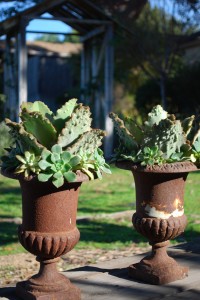 Here is a simple recipe for making Hypertufa* Troughs. These beautiful troughs resemble the centuries-old stone troughs you see in Europe. The troughs are beautiful when potted, and because of their primitive style, are especially striking planted with succulents.
Here is a simple recipe for making Hypertufa* Troughs. These beautiful troughs resemble the centuries-old stone troughs you see in Europe. The troughs are beautiful when potted, and because of their primitive style, are especially striking planted with succulents.
"Hypertufa Trough Recipe"
1 part perlite or vermiculite 1 part sphagnum peat moss 1 part Portland cement 1 small handful synthetic fiber reinforcement material 1 part water, approximately Plastic bowls, shoe boxes, or a mold of your liking similar in size Soil to pot trough Succulents or other plant material
Put dry materials in a large container such as a wheelbarrow, in this order: 1 bucket perlite or vermiculite, 1 bucket peat moss (remove any large lumps or sticks), 1 bucket of Portland cement, and a small handful of loose reinforcing fibers (these are sold at masonry supply stores). Mix thoroughly. Add water in small increments and mix until the material is the consistency of dry cottage cheese or thick oatmeal. Don't let the mixture get too wet.
Line the inside of your bowls or shoe boxes with plastic bags or plastic wrap. Using a rubber glove, scoop handfuls of mixture and mold the inside of your containers. Form mixture around edges 3/4" to 1" thick. Poke 1-2 drainage holes in the bottom of the mixture with your finger, stick or dowel. Cover the mold well with plastic or place in a plastic bag for 24 hours.
After setting 24 hours, carefully remove the very fragile trough from its mold and peel off the plastic. Use a wire brush or a paint-scraping tool to smooth out any imperfections, and give the exterior a pleasing texture. The edges should be softened, rounded, and somewhat irregular.
Place the trough back in its plastic bag and let it cure for a couple of weeks. The slower it cures, the stronger the trough will be. Remove the trough from the bag and allow to air-dry for a couple of weeks longer. When completely dry, carefully move a propane torch quickly over the surface to burn off any reinforcing fibers that are exposed. The number of troughs which can be made from this recipe is dependent on your mold sizes. This recipe may be doubled and still fit in a wheelbarrow.
These troughs are great on outdoor tables, patios, or as a special gift to someone. This recipe is from dear friends, who like to have a trough-making party once a year.
-Glossary-
*Hypertufa---is a man-made rock substance intended to assimilate natural tufa, which is a form of porous limestone rock. It is created by mixing dry cement, perlite, peat moss, and water. It is used in rock gardens, and is quite effective as a plant container.


